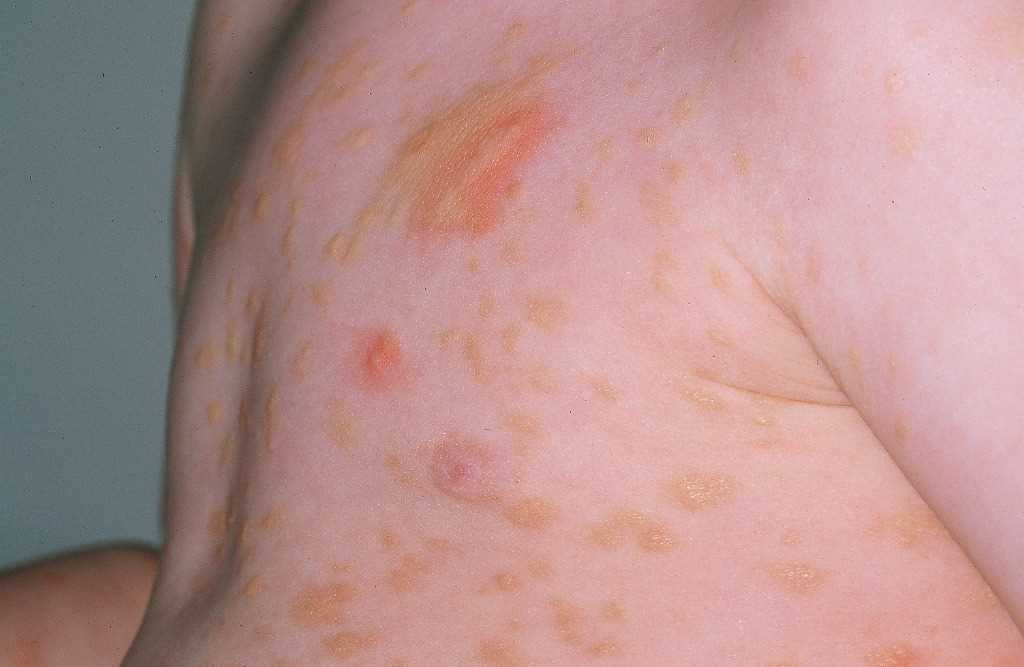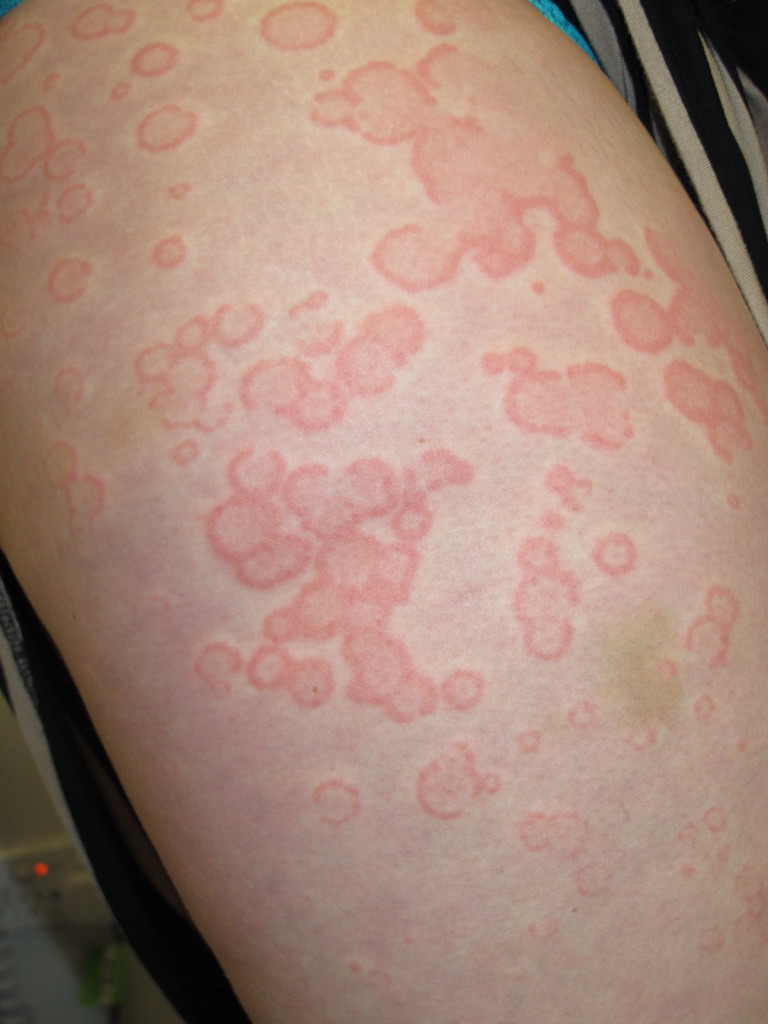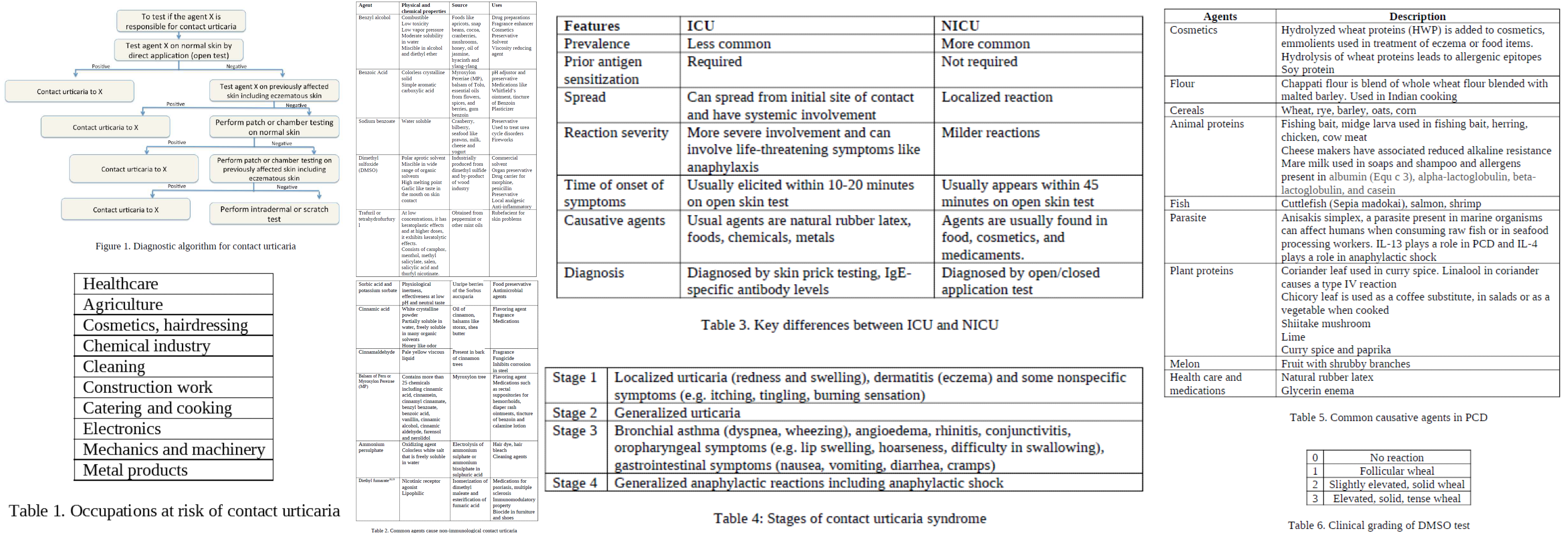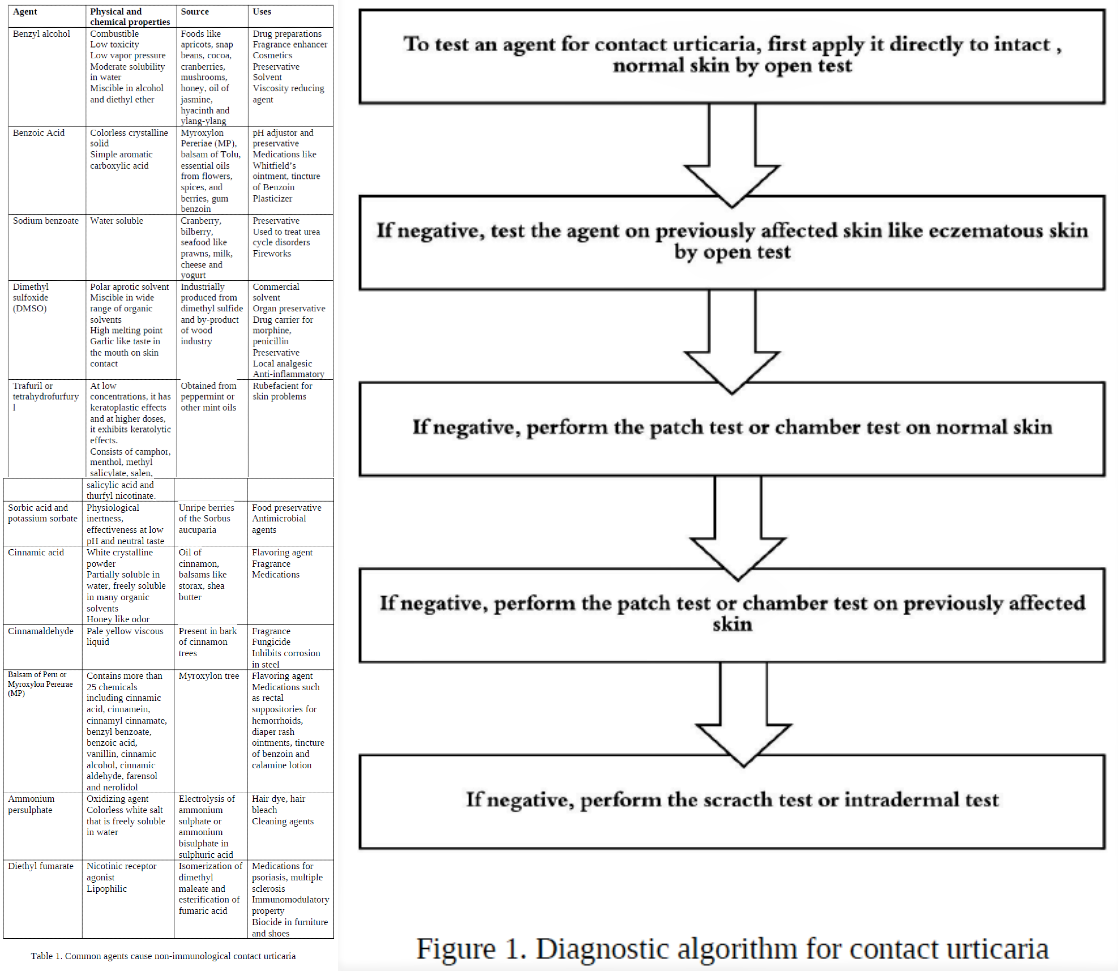[1]
Orb Q, Millsop JW, Harris K, Powell D. Prevalence and interest in the practice of scratch testing for contact urticaria: a survey of the American contact dermatitis society members. Dermatitis : contact, atopic, occupational, drug. 2014 Nov-Dec:25(6):366-9. doi: 10.1097/DER.0000000000000086. Epub
[PubMed PMID: 25384226]
Level 3 (low-level) evidence
[2]
Amaro C, Goossens A. Immunological occupational contact urticaria and contact dermatitis from proteins: a review. Contact dermatitis. 2008 Feb:58(2):67-75. doi: 10.1111/j.1600-0536.2007.01267.x. Epub
[PubMed PMID: 18186738]
[3]
Doutre MS. Occupational contact urticaria and protein contact dermatitis. European journal of dermatology : EJD. 2005 Nov-Dec:15(6):419-24
[PubMed PMID: 16280292]
[4]
Suneja T, Belsito DV. Occupational dermatoses in health care workers evaluated for suspected allergic contact dermatitis. Contact dermatitis. 2008 May:58(5):285-90. doi: 10.1111/j.1600-0536.2007.01315.x. Epub
[PubMed PMID: 18416759]
[5]
Valsecchi R, Leghissa P, Cortinovis R, Cologni L, Pomesano A. Contact urticaria from latex in healthcare workers. Dermatology (Basel, Switzerland). 2000:201(2):127-31
[PubMed PMID: 11053915]
[6]
Gimenez-Arnau A, Maurer M, De La Cuadra J, Maibach H. Immediate contact skin reactions, an update of Contact Urticaria, Contact Urticaria Syndrome and Protein Contact Dermatitis -- "A Never Ending Story". European journal of dermatology : EJD. 2010 Sep-Oct:20(5):552-62. doi: 10.1684/ejd.2010.1049. Epub 2010 Aug 23
[PubMed PMID: 20732848]
[7]
Kanerva L, Toikkanen J, Jolanki R, Estlander T. Statistical data on occupational contact urticaria. Contact dermatitis. 1996 Oct:35(4):229-33
[PubMed PMID: 8957643]
[9]
Süß H, Dölle-Bierke S, Geier J, Kreft B, Oppel E, Pföhler C, Skudlik C, Worm M, Mahler V. Contact urticaria: Frequency, elicitors and cofactors in three cohorts (Information Network of Departments of Dermatology; Network of Anaphylaxis; and Department of Dermatology, University Hospital Erlangen, Germany). Contact dermatitis. 2019 Nov:81(5):341-353. doi: 10.1111/cod.13331. Epub 2019 Jul 3
[PubMed PMID: 31173644]
[10]
Harvell J, Bason M, Maibach HI. Contact urticaria (immediate reaction syndrome). Clinical reviews in allergy. 1992 Winter:10(4):303-23
[PubMed PMID: 1295692]
[11]
Wang CY, Maibach HI. Immunologic contact urticaria--the human touch. Cutaneous and ocular toxicology. 2013 Jun:32(2):154-60. doi: 10.3109/15569527.2012.727519. Epub 2012 Oct 9
[PubMed PMID: 23046149]
[12]
Bhatia R, Alikhan A, Maibach HI. Contact urticaria: present scenario. Indian journal of dermatology. 2009 Jul:54(3):264-8. doi: 10.4103/0019-5154.55639. Epub
[PubMed PMID: 20161861]
[13]
Novembre E, Cianferoni A, Mori F, Barni S, Calogero C, Bernardini R, Di Grande L, Pucci N, Azzari C, Vierucci A. Urticaria and urticaria related skin condition/disease in children. European annals of allergy and clinical immunology. 2008 May:40(1):5-13
[PubMed PMID: 18700329]
[14]
Davari P, Maibach HI. Contact urticaria to cosmetic and industrial dyes. Clinical and experimental dermatology. 2011 Jan:36(1):1-5. doi: 10.1111/j.1365-2230.2010.03854.x. Epub
[PubMed PMID: 20456377]
[15]
McFadden J. Immunologic contact urticaria. Immunology and allergy clinics of North America. 2014 Feb:34(1):157-67. doi: 10.1016/j.iac.2013.09.005. Epub
[PubMed PMID: 24262696]
[16]
Zhai H, Zheng Y, Fautz R, Fuchs A, Maibach HI. Reactions of non-immunologic contact urticaria on scalp, face, and back. Skin research and technology : official journal of International Society for Bioengineering and the Skin (ISBS) [and] International Society for Digital Imaging of Skin (ISDIS) [and] International Society for Skin Imaging (ISSI). 2012 Nov:18(4):436-41. doi: 10.1111/j.1600-0846.2011.00590.x. Epub 2011 Nov 9
[PubMed PMID: 22093067]
[17]
Vester L, Thyssen JP, Menné T, Johansen JD. Occupational food-related hand dermatoses seen over a 10-year period. Contact dermatitis. 2012 May:66(5):264-70. doi: 10.1111/j.1600-0536.2011.02048.x. Epub
[PubMed PMID: 22486568]
[19]
Barbaud A, Poreaux C, Penven E, Waton J. Occupational protein contact dermatitis. European journal of dermatology : EJD. 2015 Nov-Dec:25(6):527-34. doi: 10.1684/ejd.2015.2593. Epub
[PubMed PMID: 26242922]
[20]
Hernández-Bel P, de la Cuadra J, García R, Alegre V. [Protein contact dermatitis: review of 27 cases]. Actas dermo-sifiliograficas. 2011 Jun:102(5):336-43. doi: 10.1016/j.ad.2011.02.005. Epub 2011 Apr 15
[PubMed PMID: 21497331]
Level 3 (low-level) evidence
[21]
Giménez-Arnau A. Contact urticaria and the environment. Reviews on environmental health. 2014:29(3):207-15. doi: 10.1515/reveh-2014-0042. Epub
[PubMed PMID: 25153542]
[22]
Lynde C, Guenther L, Diepgen TL, Sasseville D, Poulin Y, Gulliver W, Agner T, Barber K, Bissonnette R, Ho V, Shear NH, Toole J. Canadian hand dermatitis management guidelines. Journal of cutaneous medicine and surgery. 2010 Nov-Dec:14(6):267-84. doi: 10.2310/7750.2010.09094. Epub
[PubMed PMID: 21084020]
[23]
Kanerva L. Occupational protein contact dermatitis and paronychia from natural rubber latex. Journal of the European Academy of Dermatology and Venereology : JEADV. 2000 Nov:14(6):504-6
[PubMed PMID: 11444276]
[24]
von Krogh G, Maibach HI. The contact urticaria syndrome--an updated review. Journal of the American Academy of Dermatology. 1981 Sep:5(3):328-42
[PubMed PMID: 6455450]
[25]
Sabroe RA. Acute urticaria. Immunology and allergy clinics of North America. 2014 Feb:34(1):11-21. doi: 10.1016/j.iac.2013.07.010. Epub 2013 Aug 24
[PubMed PMID: 24262686]
[26]
Adisesh A, Robinson E, Nicholson PJ, Sen D, Wilkinson M, Standards of Care Working Group. U.K. standards of care for occupational contact dermatitis and occupational contact urticaria. The British journal of dermatology. 2013 Jun:168(6):1167-75. doi: 10.1111/bjd.12256. Epub
[PubMed PMID: 23374107]
[27]
Nicholson PJ. Evidence-based guidelines: occupational contact dermatitis and urticaria. Occupational medicine (Oxford, England). 2010 Oct:60(7):502-4. doi: 10.1093/occmed/kqq075. Epub
[PubMed PMID: 20871017]
Level 1 (high-level) evidence
[28]
Allmers H, Schmengler J, John SM. Decreasing incidence of occupational contact urticaria caused by natural rubber latex allergy in German health care workers. The Journal of allergy and clinical immunology. 2004 Aug:114(2):347-51
[PubMed PMID: 15316514]
[29]
Bensefa-Colas L, Telle-Lamberton M, Faye S, Bourrain JL, Crépy MN, Lasfargues G, Choudat D, RNV3P members, Momas I. Occupational contact urticaria: lessons from the French National Network for Occupational Disease Vigilance and Prevention (RNV3P). The British journal of dermatology. 2015 Dec:173(6):1453-61. doi: 10.1111/bjd.14050. Epub 2015 Oct 26
[PubMed PMID: 26212252]
[30]
Larmi E. PUVA treatment inhibits nonimmunologic immediate contact reactions to benzoic acid and methyl nicotinate. International journal of dermatology. 1989 Nov:28(9):609-11
[PubMed PMID: 2583908]
[31]
Cirla AM, Lorenzini RA, Cirla PE. [Specific immunotherapy and relocation in occupational allergic bakers]. Giornale italiano di medicina del lavoro ed ergonomia. 2007 Jul-Sep:29(3 Suppl):443-5
[PubMed PMID: 18409768]
[32]
Sastre J, Fernández-Nieto M, Rico P, Martín S, Barber D, Cuesta J, de las Heras M, Quirce S. Specific immunotherapy with a standardized latex extract in allergic workers: a double-blind, placebo-controlled study. The Journal of allergy and clinical immunology. 2003 May:111(5):985-94
[PubMed PMID: 12743562]
Level 1 (high-level) evidence
[33]
Patriarca G, Nucera E, Pollastrini E, Roncallo C, Buonomo A, Bartolozzi F, De Pasquale T, Gasbarrini G, Schiavino D. Sublingual desensitization: a new approach to latex allergy problem. Anesthesia and analgesia. 2002 Oct:95(4):956-60, table of contents
[PubMed PMID: 12351276]
[34]
Tabar AI, Gómez B, Arroabarren E, Rodríguez M, Lázaro I, Anda M. [Perspectives in the treatment of allergy to latex: immunotherapy]. Anales del sistema sanitario de Navarra. 2003:26 Suppl 2():97-102
[PubMed PMID: 13679968]
Level 3 (low-level) evidence




